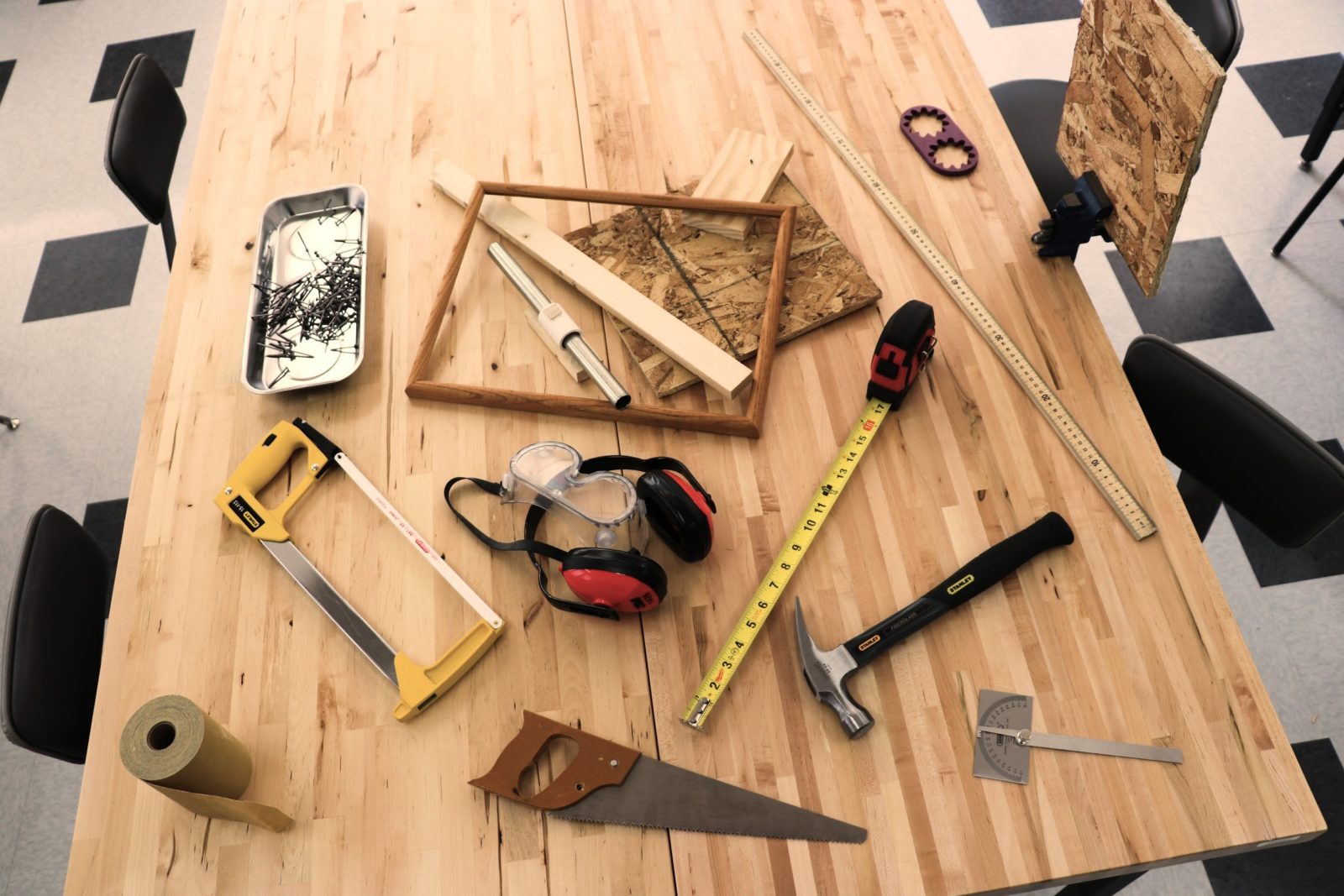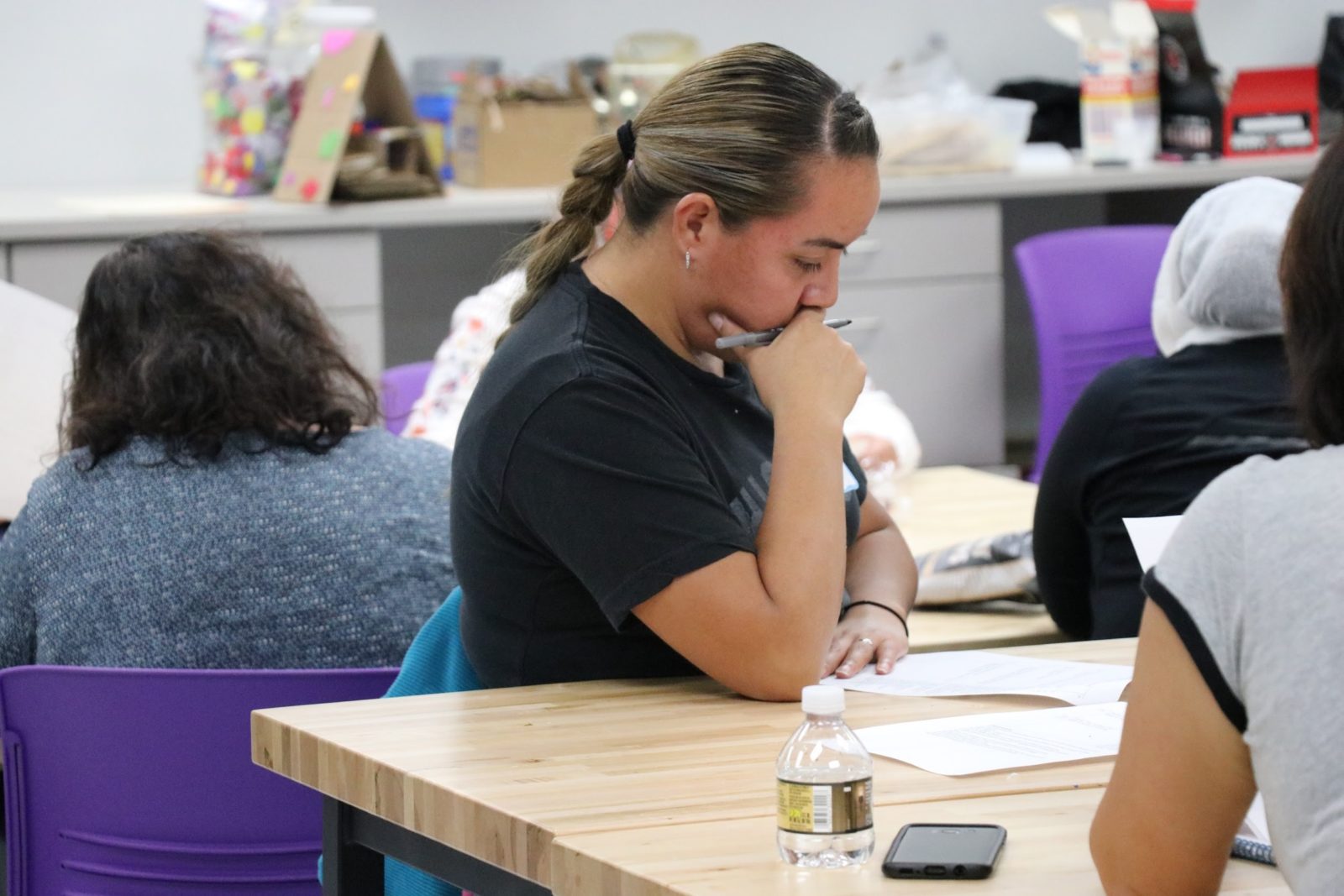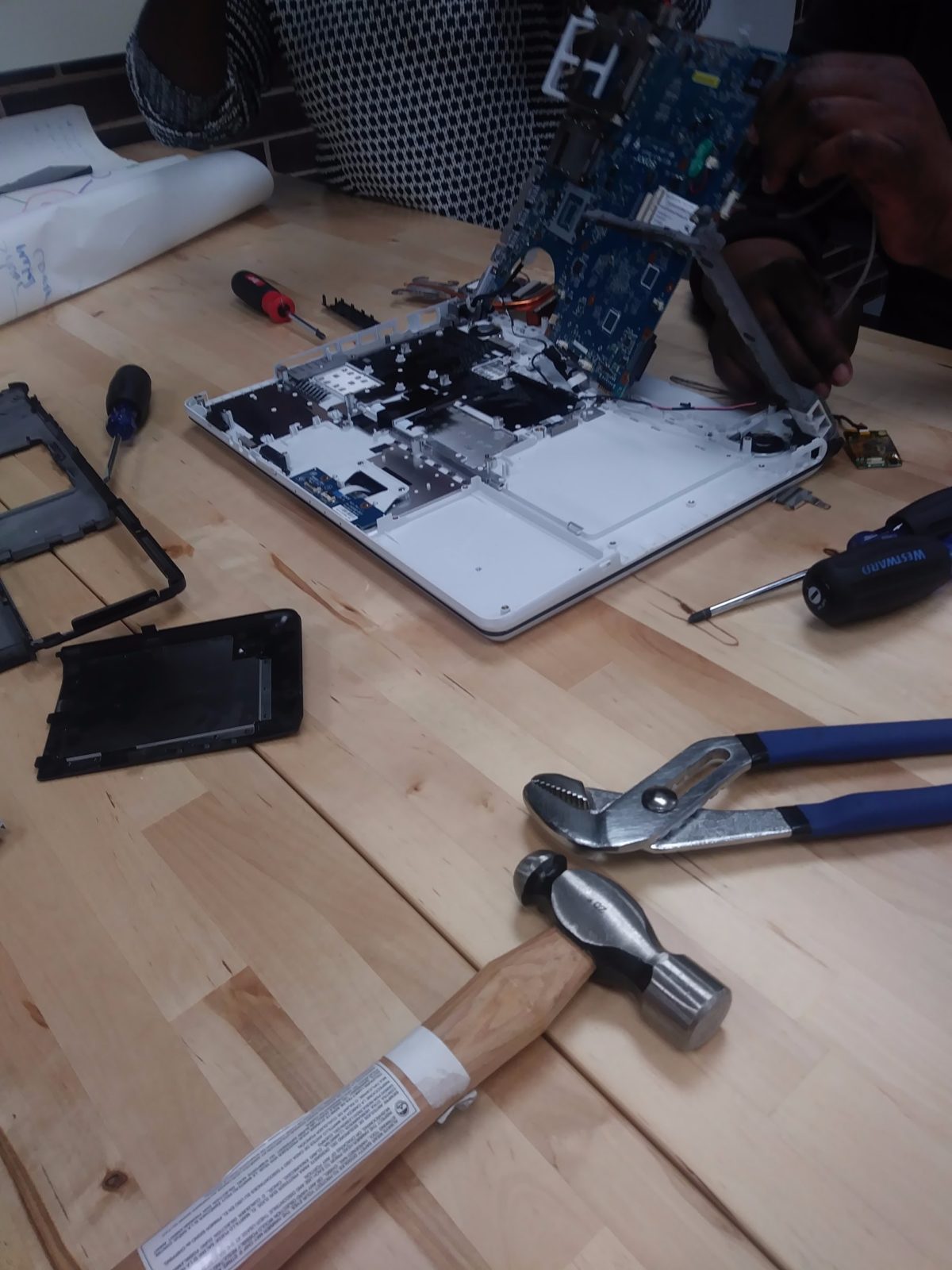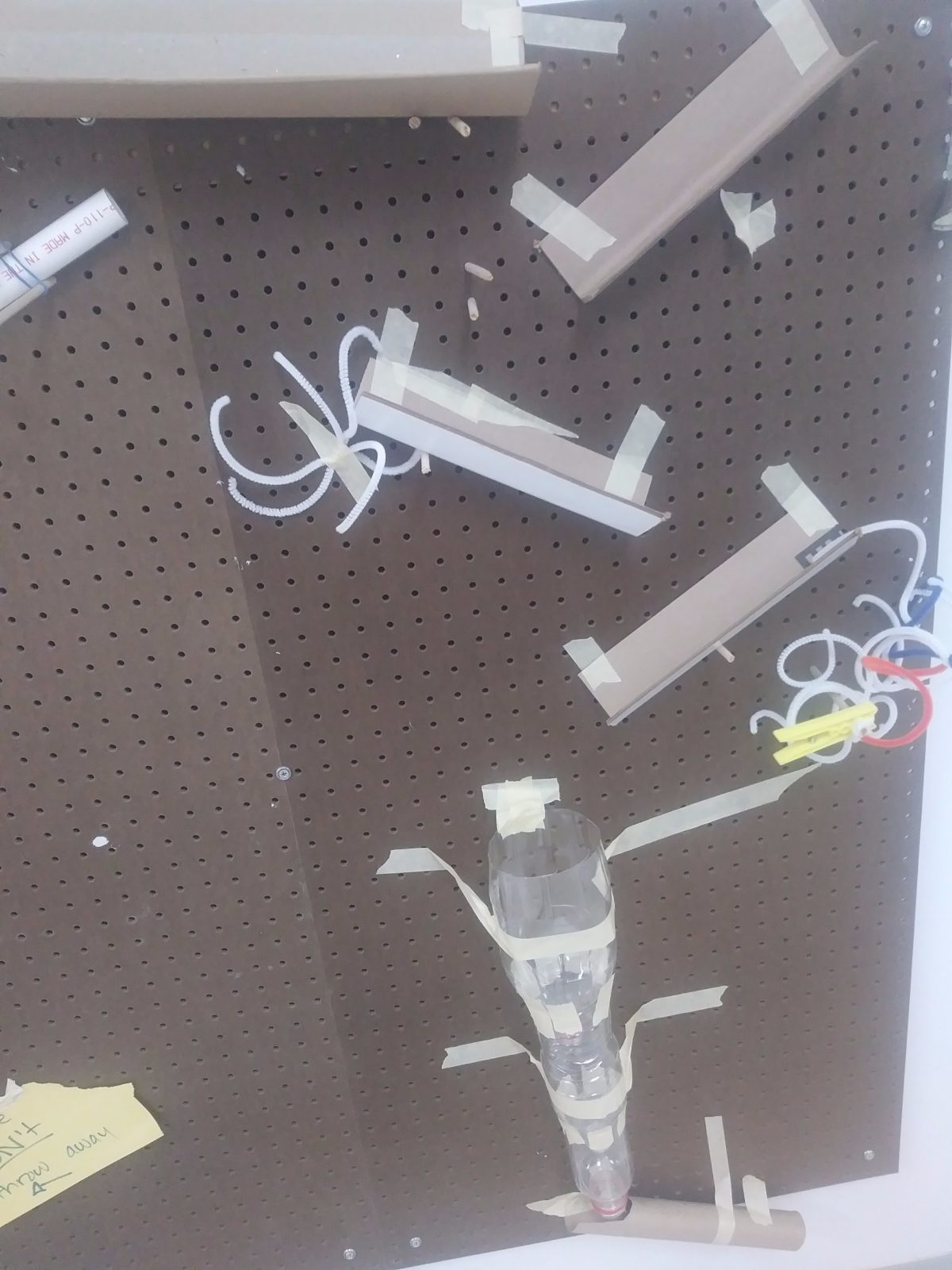Tinkering-Practical Strategies for Hands-On Math Learning
posted by Leslie Layman
At Harry S Truman College, where I serve as coordinator and adjunct faculty in the Child Development Department, we recently had the opportunity to create Early Childhood Education lab spaces. The most unique of our labs is the ECE Tinkering Lab. T lab serves as part woodshop, part methods lab, and part technology lab and is used to support early childhood educators to deepen and fine tune their practice.
Some of the tools available to students in the tinkering lab.
Much like a good early childhood environment, the lab is not focused on getting anything in particular done. It is set up to be safe, inviting, playful, and to support early childhood professionals to have meaningful experiences during which they learn by doing. You can try, fail, and try again and then reflect upon your process. A lot of our courses use the tinkering lab, but it is very often used by our Science and Math for Young Children and our professional development workshops. In retrospect, it seems so obvious that if hands on learning works for children than it must also work for adults, but even as someone who helped planned the Tinkering Lab and many of it’s activities, I am constantly surprised by the magical, early childhood style learning that takes place in it. My students literally create and learn things that I could not have imagined when I was planning my lessons.
It reminds me of the way in which young children construct knowledge. You cannot tell a child the laws of gravity, but you can watch them as they drop an object over and over again working like a scientist; making hypothesis, testing them, taking data, and coming to conclusions. This is also the case for math. Children learn math by interacting with it in meaningful, playful, everyday experiences; not through abstract lessons and memorization.
It can be hard to think about how a three year old might experience math as an everyday part of their play. I like to think of math as a language with which we make sense of our world and communicate ideas to others. Tinkering, or just messing about with things to see how they work, is an engaging way to integrate playful math into the classroom. It also relates to some of my favorite concepts of Mitch Resnick’s (Author of Lifelong Kindergarten) : low floors/high ceilings and hard fun. Tinkering is a low floor/high ceiling activity because while there is no limit to how simple the activity can be made, there is also no limit to how complex it can be either. Tinkering also embodies “hard fun” the idea that we learn best, work hardest, and enjoy ourselves most when we are being challenged doing something we are truly passionate about.
A professional development participant struggles with what to do next on her project.
Think about a class that wonders what is inside their broken toy? Why doesn’t it work? Can we fix it? If you let them take the toy apart they learn about geometry and shape, they will likely organically begin to sort and classify the pieces, they will learn about number as they find there are multiples of the same piece inside, and they will learn about size as they try to find the right screwdriver for each screw. Even better if you and the children don’t know what will be inside. This is where that learning magic happens; you couldn’t have anticipated the result.
 After predicting what might be inside, students take apart a broken laptop.
After predicting what might be inside, students take apart a broken laptop.
Another of my favorite tinkering activities that brings hands on experiences to math is a build your own marble run. A cheap and easy way to do this is to get pegboard from a local hardware store and then cut wood cooking skewers down into small pieces. You can give the children recycled materials, pvc pipe, paper, and other found materials to build the marble run and let them balance it on the dowels, tape it, or clip it together with clothespins.
 Alumni, faculty, and their children worked together to build this marble run.
Alumni, faculty, and their children worked together to build this marble run.
This particular activity is one of my favorites because the math: angles, geometry, calculations of speed and distance, etc., is embedded in the fun, children get very excited by watching the marbles. It is also very frustrating. Letting children sit with this tolerable frustration of tinkering with something that doesn’t work exactly as they would like builds not only the content knowledge, but also the self regulation and motivation skills that young children need opportunities to practice. I like to give older children (and adults) a specific challenge. I might ask them to make the marble go very, fast or make a noise. I also like to have the children work in pairs or small groups. There is nothing that builds friendships and relationship skills better than getting through a frustrating project together and being proud of the outcome.
To me this is the hardest part of the instruction, trusting yourself and that you have set the learners up with the confidence, prerequisite skills, materials and environment that they need and then really stepping back and letting them learn. Really let them get stuck and figure something out on their own. This is why I often plan learning activities to which I don’t know the correct answer, because then I can’t spoil the learning for anyone else by just telling them what to do. The other difficult thing about this type of teaching is that it requires a lot of planning. You have to know your learners, know yourself, and constantly be on the lookout for that just right experience that is going to give a child the opportunity to craft knowledge for themselves at the exact moment when they need it.
That’s just what I would hope for early learners future success with math as well. That the skill that they needed to solve a problem would be there for them in the exact moment that they really need it.
I love the idea of “let them take the toy apart they learn about geometry and shape”. I work with three years old and I would like to use it. Open together a broken toy, and explore:) Thank you!!!!
I hope you and your students have fun!
All of the activities look very intersting and fun.How would I atempt to engage my preschool class on a modified version of theses actiities. Thank you in advance.
I would totally do this activity with preschool. For a modification, I would have them draw (rather than write) a prediction of what might be inside, then give them real tools and let them really take the object apart. Start with a conversation about appropriate tool use and practice it. You may want to begin taking apart a less complicated object. VHS cassettes have worked really well for us in the past.
very interesting hands on ideas on shapes and spaces.
This was awesome. I never would have thought to let them take apart a toy.
It’s very important to have various hands on tools in the classroom for measurement.
Have you ever tabulated or listed some of the open ended scenarios that were most effective in this lab? I’m curious to know which had the most peaked interest.
We are just beginning to work on how to assess the use of these types of open ended activity. It is my dream to have an intern do this as a research project for our lab to create just such a list for us.
I really like the work you are doing with children. I’ve always loved hands-on approaches to learning and think you’re ideas are awesome! I am wondering, how might I do something like this for infants? I know they are very young, but I’m wondering what say a 9 month-1 year-old could do with this type of activity. Thank you for any input.
I like to provide hands on activities for the children to learn about math. Workshop tools and activities give the children an opportunity use numbers, measurement, size and many more math terms while enjoying playing workshop.
i like the hands on with taking apart the toys. The children love to tinker and to know that they are learning math while they r doing it is great!